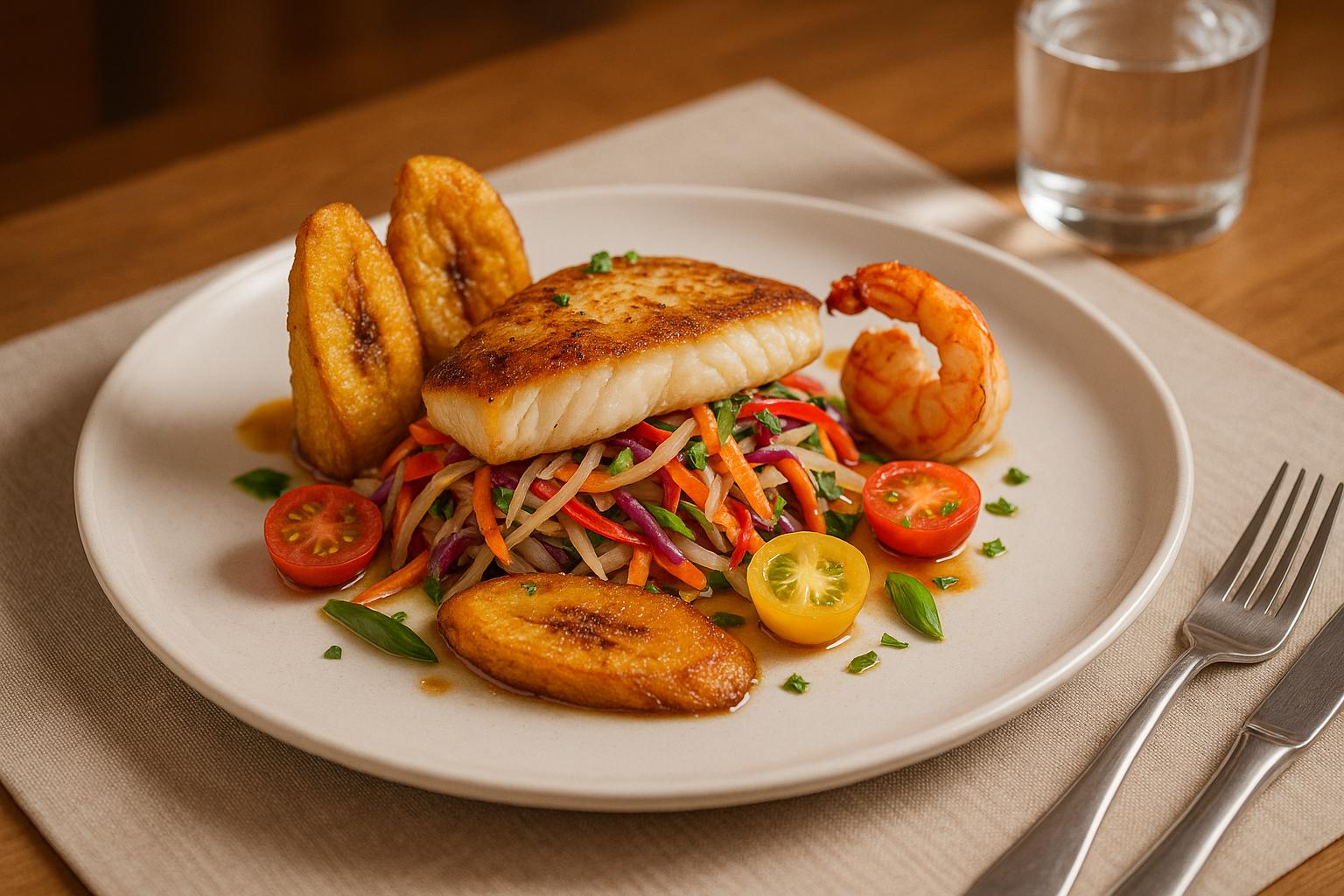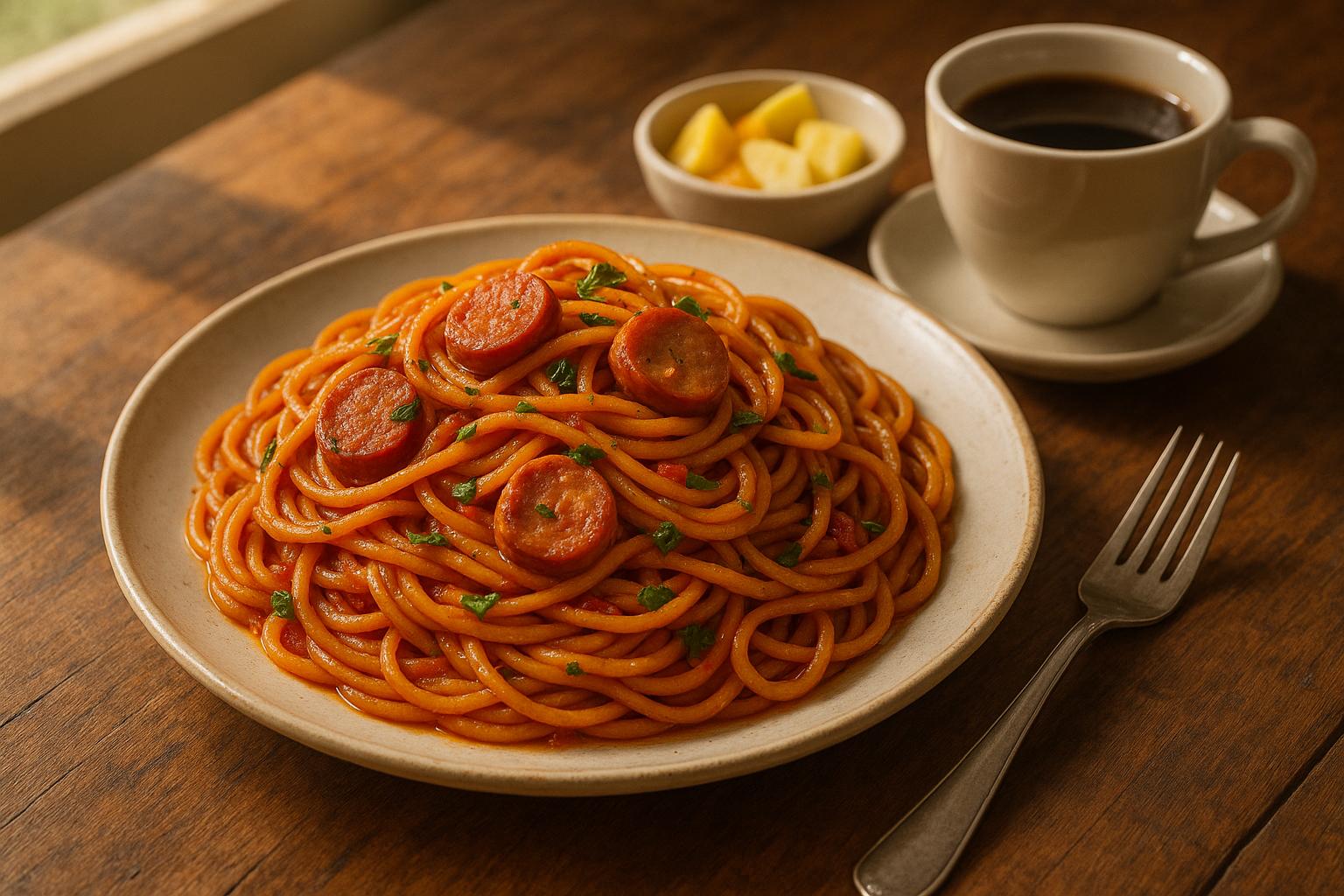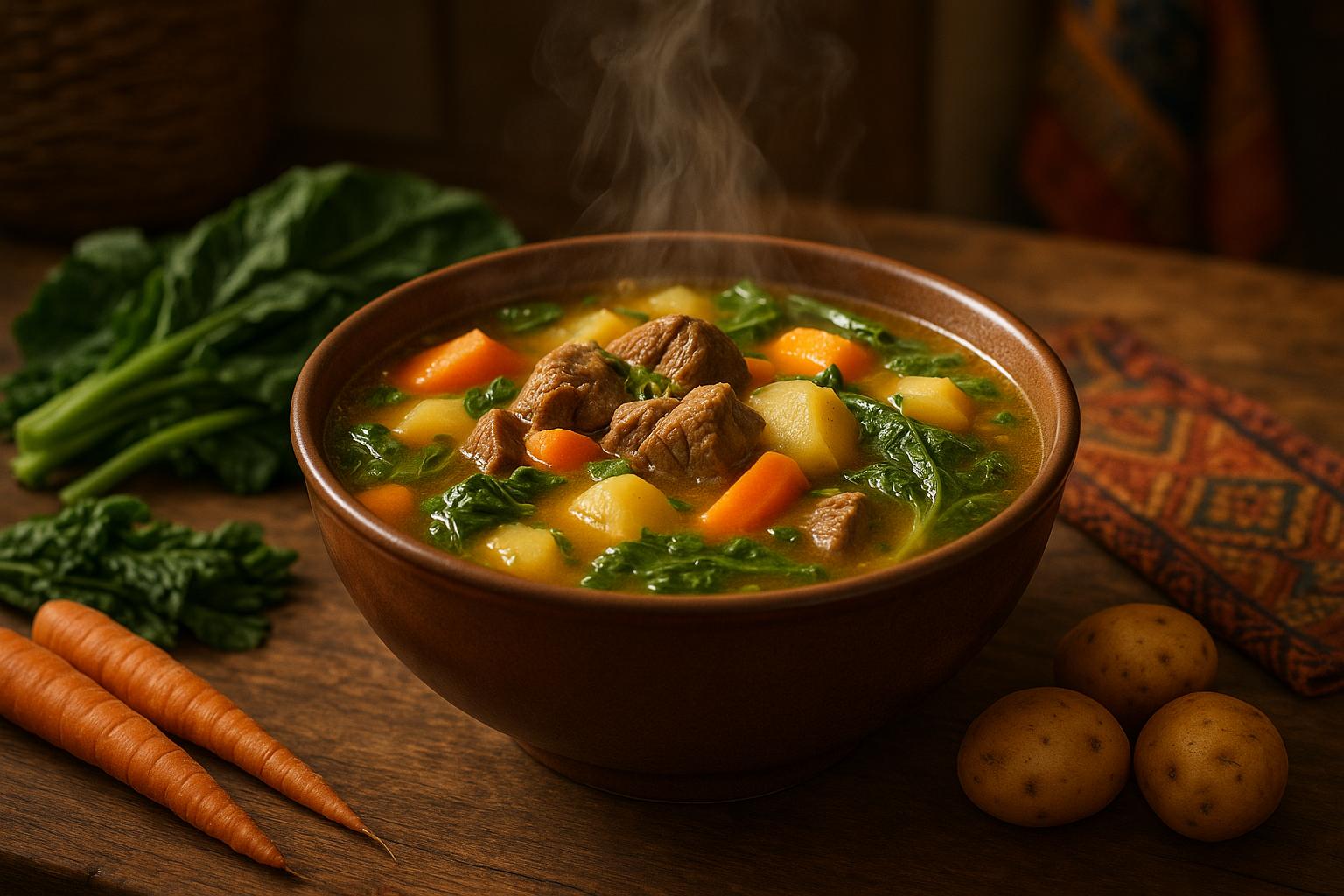Fritay, pronounced "fwee-tie", is a popular Haitian street food that translates to "fried foods" in Haitian Creole. It’s a flavorful mix of fried items like griot (seasoned fried pork), bannann peze (fried plantains), patat fris (fried sweet potatoes), and accras (vegetable fritters). Often served with pikliz, a spicy pickled vegetable relish, fritay is deeply rooted in Haiti’s culinary history, blending African and French influences.
This dish isn’t just about taste - it’s a social experience. Street vendors serve fritay as communal platters, making it a go-to for gatherings, festivals, and late-night cravings. Regional variations include fried red snapper, yuca, and tasso (fried beef or goat), reflecting local ingredients and traditions. Whether at a street corner in Port-au-Prince or a food truck in the U.S., fritay connects people through its bold flavors and rich heritage.
Quarantine Cooking: How To Make Haitian Fritay | Akra, Pikliz, Marinad, Fried Chicken, Banan Peze 🇭🇹
What Makes Up Fritay?
Fritay is a vibrant medley of fried delights, offering a street food experience that’s both flavorful and satisfying. Each platter is a curated mix of traditional ingredients, carefully prepared to deliver bold flavors and textures. Let’s take a closer look at what makes up this Haitian favorite.
Core Ingredients
At the center of every fritay platter is griot, the seasoned fried pork that’s the undeniable star of the dish. Known for its tender texture and bold, spiced flavor, griot sets the tone for the rest of the meal.
Complementing the griot are bannann peze (fried plantains), which bring a crispy exterior and a savory bite that soaks up the rich flavors of the dish. Adding a touch of sweetness, patat fris (fried sweet potatoes) balance the savory elements beautifully.
Other staples include accras, which offer a crunchy, earthy bite, and marinad, small spiced dough fritters that add a contrasting texture. Pate kode, stuffed pastries filled with seasoned meat or vegetables, delivers bursts of flavor with every bite.
For an extra layer of taste, many platters include tasso, a dried, fried meat made from beef or goat, known for its deep, savory profile. And no fritay is complete without pikliz, a spicy, pickled vegetable relish that cuts through the richness of the fried foods, adding a tangy, fiery kick.
Regional and Seasonal Differences
While the core ingredients remain consistent, fritay varies across Haiti, reflecting regional flavors and traditions. For example, in coastal areas, vendors often include fried red snapper, showcasing the local seafood bounty. In other regions, you might find yuca (cassava), served either boiled or fried, or saucisse (sausage), which reflects local tastes and ingredient availability.
Some variations even feature fried chicken or fried breadfruit, demonstrating how fritay adapts to community preferences while staying true to its roots. During Haiti’s festival season in February and March, vendors pull out all the stops, offering their finest fritay creations. And as evening falls, fresh batches of fritay become a go-to for satisfying late-day cravings, making it a beloved staple of Haitian street food culture.
How Fritay Is Prepared and Served
Fritay takes simple ingredients and transforms them into crispy, flavorful bites through techniques perfected over generations. The deep-frying process, a cornerstone of fritay, is tailored to each ingredient to bring out its best.
Preparation Methods
Deep-frying is at the heart of fritay. Take bannann peze (fried green plantains), for example: the plantains are soaked in salt water with a splash of lemon, sliced, and fried once. Then, they’re pressed flat and fried a second time, creating that irresistible crunch. For ripe plantains, a single fry is all that's needed to achieve their caramelized sweetness.
When it comes to griot and tasso, the process starts with a marinade using epis - a fragrant Haitian blend of garlic, onions, peppers, and herbs. The meat is simmered until tender, then fried to lock in juiciness while forming a crispy crust.
Accras, on the other hand, are made by mixing malanga (a root vegetable similar to taro) with herbs and spices to create a batter. This batter is then deep-fried into golden, crunchy fritters.
Judith Laguerre sheds light on the traditional techniques behind these flavors:
"We use knives to chop rather than a food processor. And we love our mortar and pestle - which we call a 'balon' - because it brings out a spice's true flavor." [5]
This hands-on approach ensures that the epis reaches its full aromatic potential, infusing every bite with authentic Haitian flavor. Once fried to perfection, the components come together for a meal that's as much about the experience as it is about the taste.
Serving Practices
Fritay isn’t just food - it’s an experience meant to be shared. It’s typically served as a communal platter, featuring a variety of fried delights, perfect for gathering friends and family. In Haiti, fritay follows a rhythm of its own, becoming a popular evening snack or late-night meal. From bustling street corners to lively gatherings, fritay is especially sought after during the festival season in February and March, when vendors showcase their best offerings [4].
No fritay platter is complete without pikliz, a spicy pickled vegetable relish that balances the richness of the fried foods. As one culinary expert puts it:
"Your fritay is not complete unless a generous serving of pikliz completes the meal. Each dish is enhanced with a serving of pikliz to entice your palate." [4]
More than just a meal, fritay is often called "midnight soul food", a comforting staple that brings people together during evening celebrations. Vendors prep ahead of time, cooking items like tasso, marinade, and pate kode the night before to handle the evening rush. Even the pikliz benefits from this preparation, as its flavors deepen and intensify overnight, making it the perfect finishing touch.
sbb-itb-80c33ff
The Role of Fritay in Haitian Culture
Fritay is a shining example of Haiti's resilience and ingenuity, blending African culinary traditions with French colonial influences to create the Creole cuisine we know today. The bold spices, one-pot cooking methods, and fiery peppers from African roots combine seamlessly with refined French techniques, resulting in fritay's unique flavors and textures.
This rich history is more than just a culinary story - it's an emotional one. For many Haitians, fritay represents transformation. It takes simple, humble ingredients and turns them into something vibrant and celebratory. This journey from struggle to joy mirrors the resilience and hope deeply embedded in Haitian culture.
Haitian Street Food Staple
Fritay has grown into more than just a meal - it's a cornerstone of Haitian street food culture. Described as "a true institution, a cultural heritage that brings together local residents and visitors around a common passion for unique flavors" [1], fritay is about more than satisfying hunger. It creates moments of connection, where people gather to share food, stories, and laughter.
Economically, fritay plays a vital role, with many families relying on street food sales to make a living [2]. These fritay stands are more than food vendors - they're community hubs. Locals catch up on neighborhood news, and visitors get a taste of Haiti's authentic flavors and warm hospitality.
The cultural reach of fritay extends far beyond Haiti, carried by the Haitian diaspora. Take, for example, Farah-Jane Jean Pierre, who launched her food truck, Fritay Haitian Cuisine, in Denver in December 2021. After moving to the U.S. following Haiti's 2010 earthquake, she noticed a lack of Caribbean food options in her new city. Her food truck became her way of sharing Haitian heritage and changing perceptions. In her words:
"For us, we want people to not be shy, to be open to try something different...Haiti is always on the news for some negative stuff, you know, so when we bring our cuisine to an event or brewery, I want people to taste a piece of home and have another conception of Haiti like, oh, the food is actually good there." [6]
Her mission highlights how fritay serves as a cultural ambassador, introducing new audiences to Haiti's rich culinary traditions while challenging old stereotypes.
Whether it's served from a street cart in Port-au-Prince or a food truck in Denver, fritay continues to tell the story of Haitian resilience and creativity. It’s a legacy that invites everyone to explore Haiti’s vibrant flavors and history, one bite at a time.
Where to Find Fritay
Finding authentic fritay in the United States has become easier as Haitian communities continue to grow. Here are some of the best places to look for this beloved dish.
Haitian restaurants are a reliable choice. Many of these establishments stick to recipes passed down through generations, offering fritay as a regular menu item or hosting special events like "fritay nights", where you can try a variety of dishes all at once.
Food trucks and mobile vendors are another excellent option, especially in urban areas. For instance, Fritay Haitian Cuisine LLC in Denver frequently updates its location on social media, making it easy for customers to track them down. Platforms like Instagram and Facebook are great for finding food trucks offering fritay, as they often share real-time updates and menu details.
Haitian festivals and cultural events provide some of the most authentic fritay experiences. These gatherings not only celebrate Haitian heritage but also showcase traditional foods. Recent events in Aurora, CO, and Brooklyn, NY, featured a wide range of fritay options. Special themed events, like Lakou Cafe's "Fritay Friday: Haitian Flag Day Edition" in Brooklyn on May 17, 2024, combine delicious food with music and drink specials. Similarly, Taste of Haiti’s "Fritay & Twoubadou" event in Atlanta on May 23, 2025, brought together food lovers for a unique experience [9][10].
Regional food festivals dedicated to Haitian cuisine are also gaining popularity. For example, the inaugural Carolina Haitian Food Festival in Charlotte, NC, on September 4, 2021, included vendors like Bon Fritay [12]. Taste of Haiti organizes events in cities such as South Florida, Orlando, Atlanta, and New York, offering a chance to sample a variety of Haitian dishes [11].
Cities with large Haitian populations - like South Florida, New York City, Boston, and Atlanta - are hotspots for fritay. In Miami, griot festivals and Haitian nightclubs often host fritay nights [8]. These events complement the year-round availability of fritay at local Haitian restaurants, giving you plenty of opportunities to enjoy this flavorful cuisine.
Finding Haitian Restaurants
If you're looking for fritay beyond festivals, Haitian restaurants are an excellent place to start. Here are some tips to help you locate the best options.
Social media platforms like Instagram and Facebook are invaluable resources. Searching hashtags such as #fritay, #Haitianfood, or #griot can lead you to local vendors. For example, Fritay Haitian Cuisine LLC (@fritayhaitianfood) and Jojo Fritay in Atlanta actively share updates about their offerings and locations [7].
For a more comprehensive search, check out HaitianFoods.org. This global directory connects users with authentic Haitian restaurants and provides detailed descriptions of traditional dishes like fritay. Restaurant owners can also submit their businesses for listing, making it a continuously growing resource for discovering new spots.
Online review sites and local food blogs are another way to find authentic fritay. Look for reviews that mention specific dishes like griot, tasso, or bannann peze, as these are staples of traditional fritay.
Lastly, don’t underestimate the power of word-of-mouth recommendations. Members of the Haitian community, local cultural centers, churches, or community organizations often know the best places to find authentic fritay. Sometimes, these recommendations may even lead you to home-based cooks who cater events or run small food businesses - hidden gems you might not find online.
Conclusion
Fritay is far more than a collection of fried foods - it’s a symbol of Haitian culinary heritage and a reflection of the community spirit woven into Haitian culture. As Lemon8 Creator maggyheavenlyta beautifully puts it: "Fritay Lakay is more than just a dish; it's a celebration of Haitian culture and tradition" [3]. This beloved cuisine brings together a variety of flavors, showcasing the diversity and richness that define Haitian cooking.
In the United States, fritay has found a home at events and festivals, where it continues to evolve while staying true to its roots. From crispy fried red snapper to the tangy kick of pikliz, every bite tells a story of tradition passed down through generations. For example, you can explore this vibrant culinary experience at the Carolina Haitian Food Festival on September 6–7, 2025, in North Carolina, or the Flavor Of Haiti Food Festival on August 30, 2025, in Orlando, Florida [13][14]. To find more events or local Haitian restaurants, visit the HaitianFoods.org directory.
Whether you’re enjoying fritay at a cultural festival, a neighborhood Haitian restaurant, or through recommendations on HaitianFoods.org, you’re partaking in something much deeper than a meal. Fritay captures the heart of Haitian cuisine - turning simple ingredients into a celebration of flavor, tradition, and togetherness.
FAQs
How does fritay vary across different regions in Haiti?
Fritay, a cherished Haitian street food, brings together the rich and varied flavors of Haiti's regions. Along the coast, it often includes seafood like fried fish or conch, showcasing the area's plentiful ocean harvests. In contrast, mountain regions focus on staples like yams, plantains, and breadfruit, highlighting the abundance of local agriculture.
These regional twists not only reflect the ingredients at hand but also honor the culinary traditions and heritage unique to each part of Haiti. This variety turns fritay into a delicious symbol of Haiti's dynamic and resourceful food scene.
How can I make authentic fritay at home, especially if I’m new to Haitian cooking?
Making fritay, the cherished Haitian street food, at home can be a rewarding experience when you follow a few key steps. Begin by marinating your meats in a mix of lime or sour orange juice and Haitian epis - a vibrant blend of herbs, garlic, and peppers. This marinade is the secret to capturing the bold, tangy flavors that are the hallmark of Haitian dishes.
For frying, focus on using fresh, high-quality ingredients, and keep the oil at a steady temperature to achieve that signature golden crisp. Take your time - proper cooking is essential for the ideal texture and flavor. With some attention to detail and practice, you can bring the irresistible taste of Haitian street food straight to your table!
How has fritay evolved within Haitian communities in the United States?
Fritay has undergone a fascinating transformation within Haitian communities in the United States, where traditional flavors meet local twists. Across the country, Haitian-owned restaurants have put their own spin on this cherished street food, making it easier to find while staying true to its roots.
The Haitian diaspora has been instrumental in spreading the love for fritay. Some entrepreneurs have even embraced fresh approaches, like fast-casual dining concepts, to introduce it to a broader audience. These creative adaptations not only celebrate the essence of Haitian cuisine but also position fritay as a vibrant and growing part of the American food scene.


